Landmarks

Ellis Avenue Gateway
Located at the intersection of Ellis Avenue and Stadium Road welcomes the University community and its visitors and guests. The Gateway adds an aesthetic to our beautiful campus. The corner sidewalk is wide and inviting, and the brick and limestone sign, accented with LED lights looks great both day and night.

Stadium Road East
Minnesota State Mankato entrance from the east end of Stadium Road.

Stadium Road West
Minnesota State Mankato entrance from the west end of Stadium Road.
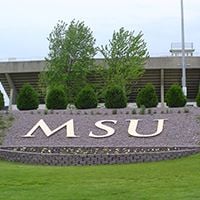
The Mound (or the "Berm")
At the intersection of Warren Street and Stadium Road, in an effort to enhance the corner where Blakeslee Stadium is located, a giant mound was created in 2001 to provide yet another aesthetic treatment of the campus grounds.

The Fountain
Located on the mall between the Centennial Student Union and Memorial Library, the fountain came from part of the New York City World Fair (1965) and was installed in 1969. It was designed to create a spiral effect with stationary water jets. The sculpture in the fountain was not originally part of the work. The sculpture, by Roger Johnson, a former faculty member in the Art Department, was added in 1975. The fountain underwent major renovation in 2013.

Marso-Schmitz Plaza
Made possible by a gift from Minnesota State Mankato Foundation president Mary Marso-Schmitz ('68), the plaza creates a place for students to relax, study, and meet others. Its design allows for outdoor music performances, as well as community and University events and receptions. You'll find this plaza in front of the Performing Arts building.
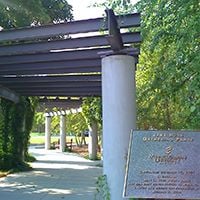
Jane Rush Gathering Place
The Jane Rush Gathering Place was created to honor the late Jane Rush's contributions to campus life. Features include an arbor, which is located over the western sidewalk of the plaza, and a small cupola located in the arbor's center. You'll find the Gathering Place in front of the Performing Arts building.
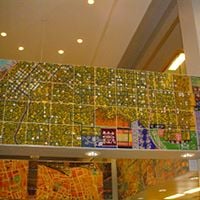
Around the World on the 44th Parallel
In three sets of four panels each, Joyce Kozloff depicts cities located near the 44th parallel around the globe. Each four by seventeen-foot panel is composed of foot-square ceramic tiles. The project was commissioned through the Minnesota Percent for Art in Public Places, sponsored by the Minnesota State Arts Board. The work was created at the Tile Guild in Los Angeles and installed in Memorial Library in June, 1995.
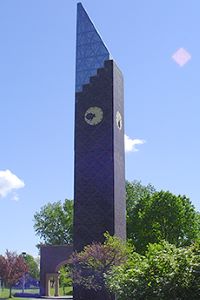 Ostrander-Student Memorial Bell Tower
Ostrander-Student Memorial Bell Tower
The Ostrander-Student Memorial Bell Tower stands in the Minnesota State Mankato campus arboretum. Its construction was made possible by an initial $138,600 gift from Lloyd B. Ostrander, a 1927 Minnesota State Mankato graduate, his wife, Mildred, and donations from the Minnesota State Mankato Student Association and other contributors. The Bell Tower, with its clock, was completed in 1989. Though known as the "bell tower," no bells exist and the music provided is from a carillon. Student Association President Kurt Battles (1986-87) was instrumental working with the Student Senate of the Minnesota State Student Association (MSSA), to provide $131,400 in part from the sale of a student activity fee funded bus, as well as from activity fee reserves. Battles' Vice President at the time was Tim Wierzbicki, who actually helped dedicate the building in a ground breaking ceremony in October, 1987, by then he was the Student Association president.
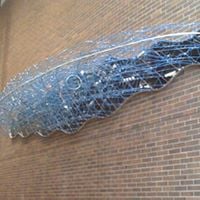 Gravity Wave
Gravity Wave
Artist Brower Hatcher created the Gravity Wave in the form of a wave, a gravity wave. A warp in the fabric of space-time appears to deform and dematerialize the brick wall of the Ford Hall. Black glass against the wall at the back of the sculpture reflects layers and objects within the structural matrix which creates the illusion of a hole through the wall. Successive layers of transparent structural "shock waves" project beyond the wall into the Ford Hall lobby. Embedded within these "shock waves" are an array of objects representative of the disciplines and fields of biochemistry, molecular biology, envirnomental biology, biology, botany, astronomy, geology, engineering, chemistry and environmental science. The network of connectivity between the variety of representative components reinforce the ideology that all disciplines are interrelated and that these elements and this progressive combination create a worldview in which knowledge is displayed as a network. This sculpture attempts to combine scientific and artistic concepts into a unified matrix that represents inquiry, observation and analysis and to provocatively announce the wide range of scientific inquiry done within Leonard A. Ford Hall to faculty, students, and visitors.
 Building Blocks
Building Blocks
This artwork was dedicated in December, 1990, following the remodeling and expansion of Wiecking Center (formerly Wilson Campus School). Artist Joyce Marguess Carey designed the piece, recognizing that much of the remodeling centered on the Department of Family and Consumer Sciences, and the Children’s House. (Both programs share the east wing of Wiecking Center.) The theme deals with children learning how to build and create new things with their hands and minds.
 Kent State - Jackson State Memorial
Kent State - Jackson State Memorial
The memorial on the northwest corner of Morris Hall was dedicated in 1972 in memory of the students who were killed in the Kent State-Jackson State protests in 1970, which were triggered by President Richard Nixon's decision to invade North Vietnamese military sanctuaries in Camboda which had been used as supply and staging areas against American and South Vietnamese troops in the Vietnam War. It states, "HATE, WAR, POVERTY AND RACISM ARE BURIED HERE." Mankato attorney Mark Halvorson, at that time a student leader and member of the campus People's Party, was instrumental in the 1970s in getting the memorial stone cut and placed on campus.
 Alumni Arch and Plaza
Alumni Arch and Plaza
An arch from Minnesota State Mankato former laboratory school from its lower campus location was incorporated into the design of the plaza near the bell tower. Dollars raised from the sale of almost 500 bricks, along with a generous donation from the Minnesota State Mankato Alumni Association, funded the first phase of the plaza which surrounds the arch. Names and sentiments from Minnesota State Mankato alumni and friends are represented in the bricks in the plaza, which was dedicated in July 1993. The Arch is in the arboretum on the east side of campus.
 The Planter
The Planter
Located near the south entrance of the Earle J. Wigley Administration building, the planter was built in 1997 through the generosity of Bolton & Menk, Cedar Lake Electric, Inspec, Johnson Controls; Johnson, Sheldon, Sorensen, Architects, L S Engineers, Robert & Jean Schramski, and F. James Zwickey.
 Shurson Garden
Shurson Garden
Located in Wiecking Center’s open courtyard, "Shurson Garden" was dedicated October 18, 1996, and named after Judy Shurson. Judy, who died after a nine month battle with cancer, was a respected and well-liked classified employee who served the University for 14 years in various capacities as Theatre Arts Business Manager, and finally as office manager and job order controller for Printing Services. Judy helped transform the neglected Wiecking Center courtyard into one full of flowering plants.
Shurson Garden is maintained by high school students in the Upward Bound Program with supervision provided by volunteers from Upward Bound.
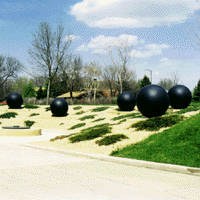 Spin
Spin
The black, cement cast spheres located at the east entrance of the Trafton Science Center were created in 1993 by Janet Lofquist. The space is graded into an amphitheater-like setting offering a welcoming entrance to the building.
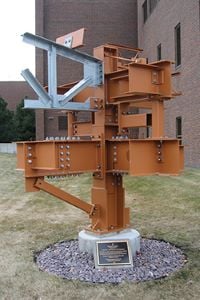 Steel Sculpture
Steel Sculpture
The Steel Sculpture and its 50 different connections (bolts and welds) is intended to help Minnesota State Mankato civil engineering students learn about typical connections as part of their steel design course, and to help other students and the public better understand the role of the civil engineer in society. It is located on the east side of Trafton East.
Materials for and fabrication of the sculpture were donated by Central Minnesota Fabrication Inc. of Willmar, Minnesota. Painting of the sculpture was donated by Central Sandblasting Inc. of Willmar.
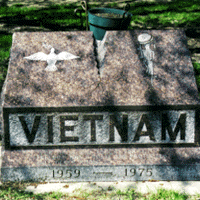 Vietnam War Memorial
Vietnam War Memorial
In 1983, the Vietnam War Memorial, located on the southeast corner of Memorial Library, was dedicated by the Minnesota State Mankato Vets Club to the veterans of the Vietnam War. The inscription, "For those who fought for it, freedom has a taste the protected will never know," was submitted by John Domeier, a Vietnam veteran; the actual author is unknown. The memorial was designed by Mark Dragan, at that time a junior at Mankato State Mankato, and a veteran of the United States Air Force.
 Waves
Waves
This red steel sculpture, titled Waves was designed by Arnoldus Grüter, and fabricated at Jones Metal Products in Mankato. It is located near Memorial Library on the Minnesota State Mankato mall. In the artists words, Waves symbolizes in static form the dynamic action of the ocean and a university. This sculpture was built in honor of Jerry W. Berger, a Mankato State graduate student who was killed in a 1969 industrial accident.
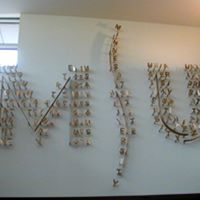 Letterdance
Letterdance
The public artwork, located in three separate sites within Highland Center, is called Letterdance and was created to reflect and enhance the internationally diverse community of Minnesota State Mankato. Letterdance is made of stainless steel, bronze and brass, and was made by Alexander Tylevich, from Saint Paul, Minnesota, who was paid $112,725 for his services, this represents almost 1% of the $11 Million dollar construction costs for Taylor Center.
The student lounge site includes colored and stainless cables holding an array of small scale images - letters of different alphabets of the languages spoken at Minnesota State Mankato, and a floor design with numerals and translucent glass like strips.
The corridor site has stainless cables which visually interplay with the lines of the track field and incorporate the university's sport song. The wall mounted site forms the abreviation (MSU) and is created by many repetitions of "Minnesota", "State" and "University".
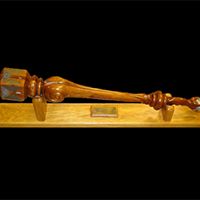 The Mace
The Mace
Made entirely from Minnesota materials in recognition of the value and beauty of the state's natural resources and people, the mace symbolizes both the university's power to overcome ignorance and prejuidice by seeking truth, and the power of the university's president to protect the university and its community from forces opposed to its goals. The mace is carried in each graduation ceremony, and was commissioned and donated to Mankato State by Fred and Karin Block. The mace was created by Phil Swan, a Mankato State University alumnus from Prior Lake, Minn.
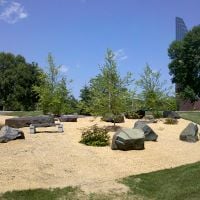 Rock Garden
Rock Garden
The Rock Garden surrounds Ford Hall. All 87 rock specimens representing the counties in Minnesota have been taken from each of the counties of Minnesota. This garden isn't just a sight to look at, but individuals can take a break or study at benches or grass patches scattered throughout the garden.
 Abraham Lincoln Statue
Abraham Lincoln Statue
The statue of Abraham Lincoln, which has a new exhibit space for in Memorial Library, has a longtime association with the university. The landmark has been on campus since 1926, according to Minnesota State Mankato archives. Campus Planner Ira Johnson, tired of the Abe's head disappearing from time to time, in the 1970s glued it on permanently to stop the pranks.
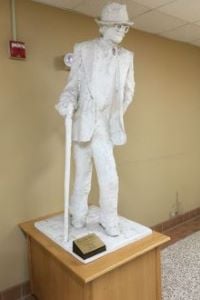 Old Man Statue
Old Man Statue
The statue of The Old Man, which has graced the halls of Wiecking Center since 1983, was the creation of Instructor Kristy Mondell's Upward Bound sculpture class. It remains the only class project which morphed into a "go see" piece of University history located on the north end of the campus.
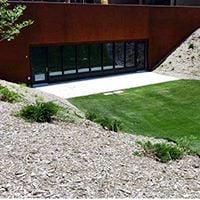 Amphitheatre
Amphitheatre
The Amphitheatre is located between Memorial Library and the Centennial Student Union. The glass windows at its base are part of the tunnel connection between the library and student union.
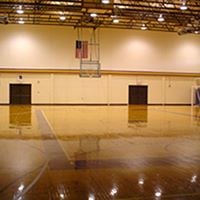 Schellberg Gym
Schellberg Gym
Schellberg Gymnasium, named in honor of Ruth Schellberg, former chairperson of women’s P.E. at Minnesota State Mankato, is part of Highland Center North.
 Elias J. Halling Recital Hall
Elias J. Halling Recital Hall
Located in the Performing Arts Building, Elias. J. Halling came to Mankato State Mankato (then Mankato State Teachers College) as a vocal music teacher in 1936 and became prominent in Minnesota as a director of Mankato State choral groups, including the Madrigal Singers which he founded.
He was chair of the Music Department and the Division of Fine and Applied Arts before becoming assistant dean of the Mankato State School of Arts and Science in 1964. Halling retired in 1974 as associate dean of the Minnesota State Mankato School of Arts and Science. The recital in the Minnesota State Mankato Performing Arts Center was named for him.
In 1980 he was presented the F. Melius Christiansen Memorial Award from the Minnesota Chapter of the American Choir Directors Association in recognition of outstanding contributions to choral music in Minnesota. Other awards included the Minnesota Music Educator's Citation for 40 years' service in school music in Minnesota, 1966; and the Governor's Award for Outstanding Work in College Choral Music in Minnesota, from Governor Orville Freeman, 1963.
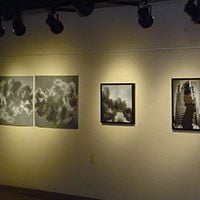 Effie R. Conkling Art Gallery
Effie R. Conkling Art Gallery
Named after emeritus professor of art, Effie Conkling, the Conkling Gallery enhances the education of our students by sponsoring professional exhibitions of regional, national, and international artists. The Conkling Gallery also provides space for senior undergrad and graduate thesis exhibitions. You'll find Conkling Gallery in Nelson Hall.
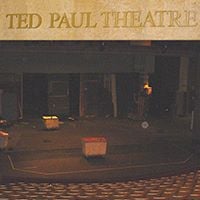 Ted Paul Theatre
Ted Paul Theatre
Located in the Performing Arts building, the theatre was named in honor of professor of theatre arts and former chairperson of the Theatre Arts Department, the theatre is used for all main stage theatre productions.
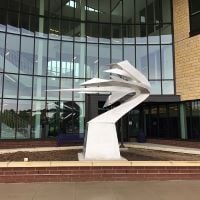 Toward Tomorrow
Toward Tomorrow
Installed outside of the Clinical Sciences building August 2018. "Toward Tomorrow is a linear projectile that is defined by the receding lines, and the suspended interior portion provides a sense of weightlessness. The form can become relatable when seen in relation to the self, and in that way connections can be made between ourselves and the space that we occupy." - Tommy Riefe Sculptor
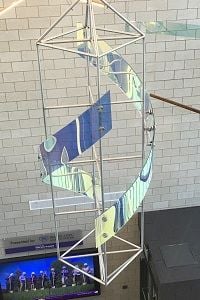 Continuum
Continuum
Installed inside of the Clinical Sciences building Fall 2018. Aleander Tylevich’s spiral artwork moves and seems ever changing, and, depending on what angle you view it from, the piece projects something new. Separated it means little, but as a continuous whole it engages the imagination, not unlike life itself.
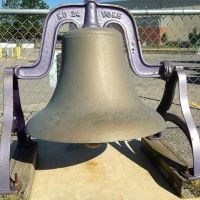 Victory Bell
Victory Bell
The Victory Bell was used by the Mavericks Football team for the first time on Saturday, October 12, 2002, when Minnesota State Mankato hosted Nebraska-Omaha in Minnesota State Mankato 70th Homecoming Game (lost 21-15). Former Minnesota State Mankato student Curt Fisher presented the bell known then as the Alpha Tau Omega Fraternity Bell, which is now a special feature at all home football games. Fisher recalls that as a student in the late 60;s and early 70's, it was a chore to get ATO's unwieldy bell up into the stands at every home football game. ATO's bell is now Minnesota State Mankato Victory Bell. At the conclusion of each game where the Mavericks win, every football player is expected to ring the bell. The sound waves reverberate between the interior walls of the oval shaped 6,000 seat stadium making quite a racket.

